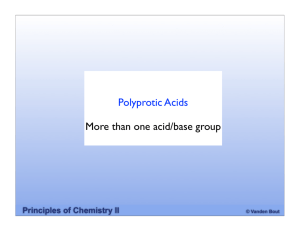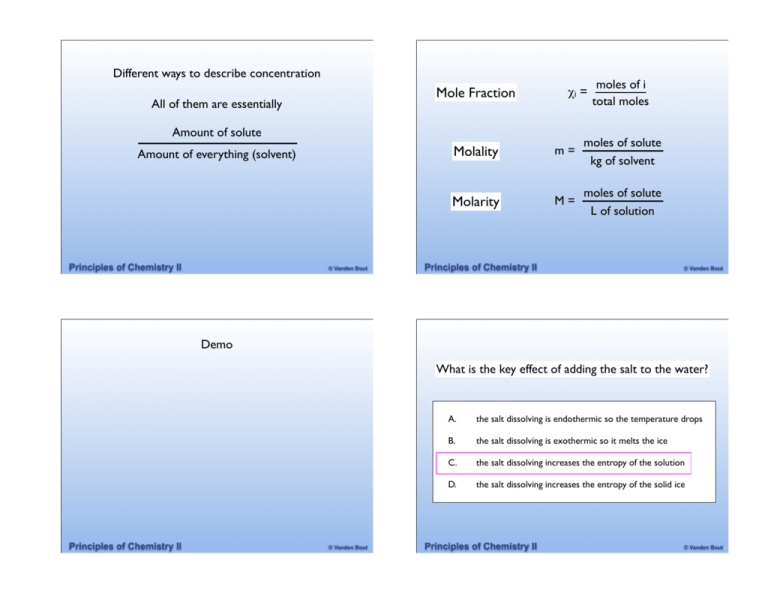
Different ways to describe concentration
Mole Fraction
All of them are essentially
!i =
Amount of solute
Amount of everything (solvent)
Principles of Chemistry II
© Vanden Bout
moles of i
total moles
Molality
m=
moles of solute
kg of solvent
Molarity
M=
moles of solute
L of solution
Principles of Chemistry II
© Vanden Bout
Demo
What is the key effect of adding the salt to the water?
Principles of Chemistry II
© Vanden Bout
!
A.! !
the salt dissolving is endothermic so the temperature drops
!
B.! !
the salt dissolving is exothermic so it melts the ice
!
C.! !
the salt dissolving increases the entropy of the solution
!
!
D.! !
the salt dissolving increases the entropy of the solid ice
Principles of Chemistry II
© Vanden Bout
Solutions
Why does the temperature drop?
!
A.! !
the salt dissolving requires energy (endothermic)
!
B.! !
the salt dissolving releases energy (exothermic)
!
C.! !
the ice melting releases energy (exothermic)
!
!
D.! !
the ice melting requires energy (endothermic)
Principles of Chemistry II
The main effect of making a solution is that
the entropy of the solution is higher than the
separate solvent and solute
T = 0°C and P = 1 atm
G
solid water
ice will melt to get
intothe lower free
energy solution
© Vanden Bout
liquid water
solution
they have the same
free energy at
equilibrium
the solution has a higher
entropy and therefore
a lower free energy
NOW MOST STABLE
Principles of Chemistry II
© Vanden Bout
Somethings dissolve into ions making more moles
This effect depends on the entropy of the
solution which depends on how much "stuff"
is dissolved but not what the "stuff" is
1 M sugar solution = 1 moles of sugar in 1 L solution
Colligative Properties
depend on the concentration of the solution
but not what is actually dissolved
(note: this is approximate as it assumes and
ideal solution)
1 M NaCl solution = 1 moles of Na+ in 1 L solution
I mole of Cl- in 1 L solution
2 moles of "stuff"
The only thing that matters is the number of
moles of "stuff"
Principles of Chemistry II
© Vanden Bout
Principles of Chemistry II
© Vanden Bout
Van't Hoff Number
i=
Effect of making the solution
moles of "particles" in solution
Boiling Point Elevation
moles of solute dissovled
Solution now more stable
than vapor. Therefore the
boiling point goes up
Freezing Point Depression
Solution now more stable
than solid. Therefore the
freezing point goes down
Figure Copyright Houghton Mifflin
Company. All rights reserved
Principles of Chemistry II
© Vanden Bout
Principles of Chemistry II
constant that depends on solvent
Boiling Point Elevation
!T = Kbmsolute
© Vanden Bout
constant that depends on solvent
Freezing Point Depression
!T = -Kfmsolute
molality solute
Remember the number of particles is what matters
!T = iKbmsolute
Principles of Chemistry II
molality solute
Remember the number of particles is what matters
!T = -iKfmsolute
© Vanden Bout
Principles of Chemistry II
© Vanden Bout
Which would you expect to have the lowest freezing point
!
A.! !
2 M sugar solution
!
B.! !
0.5 M NaCl solution
!
C.! !
1 M NaCl solution
!
D.! !
1 M MgCl2 solution
!
Figure Copyright Houghton Mifflin
Company. All rights reserved
Principles of Chemistry II
© Vanden Bout
Principles of Chemistry II
© Vanden Bout
Raoult's Law
If the boiling point is higher,
what is the vapor pressure of the solution?
vapor pressure of pure solvent
!
A.! !
higher than the pure solvent
!
B.! !
lower than the pure solvent
!
C.! !
the same as the pure solvent
Psolvent = XsolventP°
mole fraction of solvent!
!
Principles of Chemistry II
© Vanden Bout
Principles of Chemistry II
© Vanden Bout
Osmosis
Reverse Osmosis
Solvent can pass through the membrane
but the solute can't
Solution is lower in free energy so pure
solvent moves to the solution side
Principles of Chemistry II
© Vanden Bout
Principles of Chemistry II
Osmotic Pressure
Cells
pure water
" = MRT
Osmotic pressure
© Vanden Bout
pure water
Molarity of solution!
" = iMRT
Principles of Chemistry II
high conc "stuff"
© Vanden Bout
Principles of Chemistry II
high conc "stuff"
© Vanden Bout
Examples
Solution
of
100 g of sugar (sucrose MW 342 g mol-1) in 1 L of water.
(100 g)/(342 g mol-1) = 0.292 mol sugar
1 L water is approx. 1 kg
(1000 g)/(18 g mol-1) = 55.6 moles
Mole fraction sugar of solution
χsugar = (0.292 mol)/(0.292 + 55.6) = .00522
Mole fraction water of solution
χwater = (55.6 mol)/(0.292 + 55.6) = 0.995 (or 1- χsugar)
Molality
m = (.292 mol)/(1 kg) = 0.292 mol kg-1
Molarity
M = (.292 mol)/(1 L) = 0.292 mol L-1
Freezing point depressions (given Kf for water is 1.86)
ΔT = -iKfm= -(1)(1.86)(.292) = -0.543 °C
Boiling point elevation (given Kb for water is 0.51)
ΔT = -iKbm= -(1)(0.51)(.292) = +0.15 °C
Osmotic Pressure (at 25°C)
Π = MRT= (1 mol L-1)(0.08206 L atm K-1 mol-1)(298.15 K) = 24.5 atm
Vapor Pressure (given pure vapor pressure of water at 25°C is 23.76 Torr)
PH2O = χH2OP° = (.995)(23.76) = 23.64 Torr

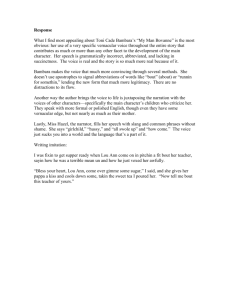
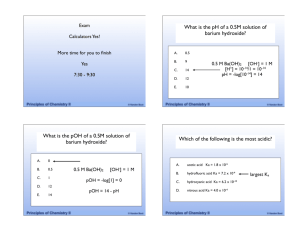
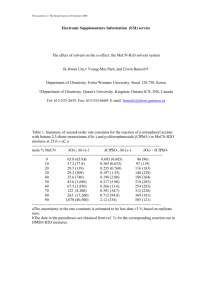
![pH = -log[H+]](http://s3.studylib.net/store/data/008427242_1-6a856521ca6b3bcc442fa00c77f4fe6e-300x300.png)
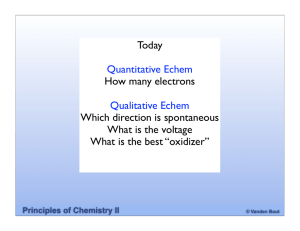





![log(10-14) = log[H+]+ log[OH-] -14 = -pH](http://s3.studylib.net/store/data/008348689_1-ecdbf98005ad825214c83510bb4d3705-300x300.png)
